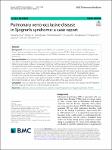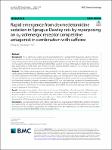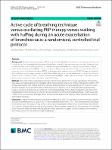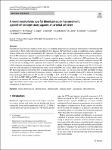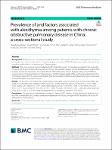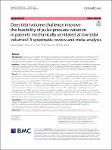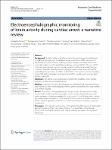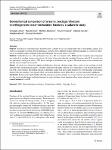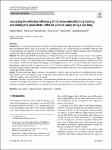Search
Author
- Daqing, Ma (3)
- Alexis, Ferré (2)
- Anna, Lybeck (2)
- Ashish K., Khanna (2)
- next >
Subject
- intensive care unit (8)
- acute respiratory dist... (5)
- chronic obstructive pu... (5)
- ICU (5)
- next >
Has File(s)
Search Results
Pulmonary arterial hypertension (PAH) associated with connective tissue disease (CTD) belongs to Group 1 pulmonary hypertension. Pulmonary veno-occlusive disease (PVOD), which is characterized by venous system aberrations, has been previously reported in CTD-PAH; however, it has rarely been observed in Sjogren’s syndrome (SS). |
Disseminated cryptococcal infection is especially prone to occur in immunosuppressed hosts. We herein report the case of an immunosuppressed girl with disseminated cryptococcal infection in whom pulmonary cryptococcosis (PC) presented as diffuse cavitary pulmonary nodules, a finding which has rarely been reported. |
The α2 adrenergic receptor agonist dexmedetomidine is an important intravenous sedative with analgesic properties. Currently available dexmedetomidine reversal agents, like the α2-receptor antagonist atipamezole, cause serious adverse effects at the large dosages required for effective reversal; they are not used clinically. Without reversal agents, emergence times from dexmedetomidine sedation are slow. In this study we tested the ability of low-dose atipamezole, in combination with caffeine, to reverse dexmedetomidine sedation. The low dose of atipamezole employed should not be associated with unwanted effects. |
Airway clearance techniques (ACTs) for individuals with bronchiectasis are routinely prescribed in clinical practice and recommended by international guidelines, especially during an acute exacerbation. However, there is limited evidence of the efficacy of these techniques during an exacerbation to improve sputum expectoration, health-related quality-of-life (HRQOL) or exercise tolerance. The primary aim of this study is to compare the effects of the active cycle of breathing technique (ACBT), oscillating positive expiratory pressure (O-PEP) therapy, and walking with huffing on sputum expectoration for adults hospitalised with an acute exacerbation of bronchiectasis. |
Smartphones may provide a highly available access to simplified hypertension screening in environments with limited health care resources. Most studies involving smartphone blood pressure (BP) apps have focused on validation in static conditions without taking into account intraindividual BP variations. We report here the first experimental evidence of smartphone-derived BP estimation compared to an arterial catheter in a highly dynamic context such as induction of general anesthesia. We tested a smartphone app (OptiBP) on 121 patients requiring general anesthesia and invasive BP monitoring. |
Alexithymia is a common psychological disorder. However, few studies have investigated its prevalence and predictors in patients with chronic obstructive pulmonary disease (COPD). Therefore, we aimed to determine the prevalence and predictors of alexithymia in Chinese patients. |
Pulse pressure variation (PPV) has been widely used in hemodynamic assessment. Nevertheless, PPV is limited in low tidal volume ventilation. We conducted this systematic review and meta-analysis to evaluate whether the tidal volume challenge (TVC) could improve the feasibility of PPV in patients ventilated at low tidal volumes. |
To date cardiac arrest (CA) remains a frequent cause of morbidity and mortality: despite advances in cardiopulmonary resuscitation (CPR), survival is still burdened by hypoxic–ischemic brain injury (HIBI), and poor neurological outcome, eventually leading to withdrawal of life sustaining treatment (WLST). The aim of CPR is cardiac pump support to preserve organ perfusion, until normal cardiac function is restored. However, clinical parameters of target organ end-perfusion during CPR, particularly brain perfusion, are still to be identified. In this context, electroencephalography (EEG) and its derivatives, such as processed EEG, could be used to assess brain function during CA. |
Osteoporosis-related proximal femur fractures continue to increase significantly due to demographic change. This study was designed to evaluate the biomechanical stability of two different fixation methods (cerclage vs. screw) for refixation of a trochanter minor fragment in the pertrochanteric fractures in cadaveric bones. |
As volatile anaesthetic gases contribute to global warming, improving the efficiency of their delivery can reduce their environmental impact. This can be achieved by rebreathing from a circle system, but also by anaesthetic reflection with an open intensive care ventilator. We investigated whether the efficiency of such a reflection system could be increased by warming the reflector during inspiration and cooling it during expiration (thermocycling). |

